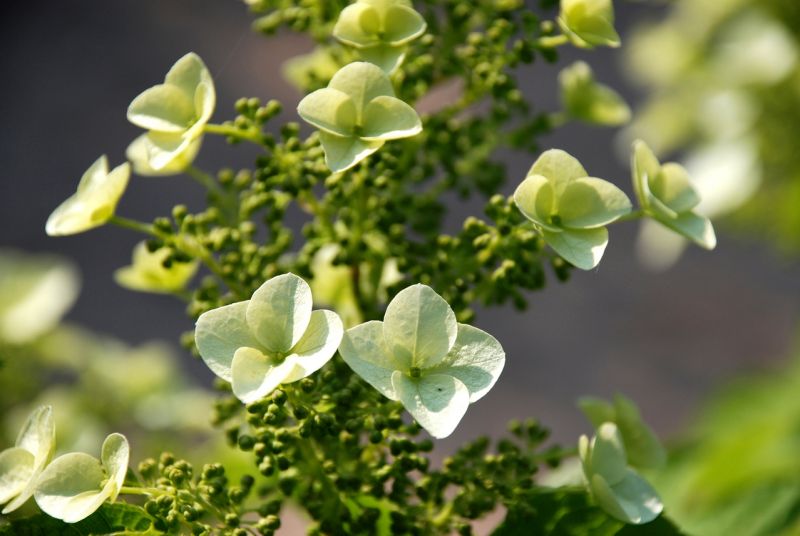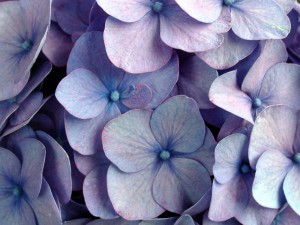18 August 2015
Using Hydrangeas in the Garden
 In a container: Hydrangeas all enjoy plenty of moisture. If you can’t, or don’t wish to spend time watering the garden but can manage a few containers, fill one or more with hydrangeas. Paired pots of hydrangeas are round in shape, have a formal look and look good placed one each side of a path or entrance. Try the stylish white-flowered Hydrangea macrophylla 'Black Steel Zebra' which is around a metre in height and spread, with a floral season that starts in July. For a really compact container plant the 45cm high Hydrangea macrophylla 'Papillon' which has flowers that are pink in alkaline soil and shaped like some begonias. This could be placed with containers of Begonia (Nonstop Series), to intriguing effect and they should both start to flower during July. In the border: Hydrangeas can be surprisingly effective as part of a mixed planting in a flower border. The more delicate flowers of the lacecap forms with their domed heads can be interesting. For pink flowers try with frothy magenta pink Astilbes such as Astilbe chinensis var. tacquetii 'Superba', or as a contrast to elegant hardy Lobelias such as Lobelia 'Compton Pink'. Alternatively the exuberant whorled flowers of Monarda such as pale pink Monarda 'Fishes' make good companions. If you have acidic soil and can grow those elusive blue hydrangeas (for example 1.5 metre high lacecap Hydrangea macrophylla 'Zorro', try them with the dark blue columnar flowers of monkshood such as Aconitum napellus, the warm lavender-blue of Phlox paniculata 'Eventide', or the stately pale blue spikes of Veronicastrum virginicum. All these border selections enjoy plenty of moisture.
In a container: Hydrangeas all enjoy plenty of moisture. If you can’t, or don’t wish to spend time watering the garden but can manage a few containers, fill one or more with hydrangeas. Paired pots of hydrangeas are round in shape, have a formal look and look good placed one each side of a path or entrance. Try the stylish white-flowered Hydrangea macrophylla 'Black Steel Zebra' which is around a metre in height and spread, with a floral season that starts in July. For a really compact container plant the 45cm high Hydrangea macrophylla 'Papillon' which has flowers that are pink in alkaline soil and shaped like some begonias. This could be placed with containers of Begonia (Nonstop Series), to intriguing effect and they should both start to flower during July. In the border: Hydrangeas can be surprisingly effective as part of a mixed planting in a flower border. The more delicate flowers of the lacecap forms with their domed heads can be interesting. For pink flowers try with frothy magenta pink Astilbes such as Astilbe chinensis var. tacquetii 'Superba', or as a contrast to elegant hardy Lobelias such as Lobelia 'Compton Pink'. Alternatively the exuberant whorled flowers of Monarda such as pale pink Monarda 'Fishes' make good companions. If you have acidic soil and can grow those elusive blue hydrangeas (for example 1.5 metre high lacecap Hydrangea macrophylla 'Zorro', try them with the dark blue columnar flowers of monkshood such as Aconitum napellus, the warm lavender-blue of Phlox paniculata 'Eventide', or the stately pale blue spikes of Veronicastrum virginicum. All these border selections enjoy plenty of moisture.  For something dramatic: Hydrangea paniculata forms can stand 3 metres or more in height and are at their best from late summer, going through autumn. They develop large heads of conical flowers, often white or pink, and turn pink with age. They are spectacular in flower, yet often overlooked. These need plenty of moisture and acidic or neutral soil. Try 3 metres tall Hydrangea paniculata 'Brussels Lace', or for a small garden use modern cultivars at half the height such as Hydrangea paniculata 'Silver Dollar'. Smaller Hydrangea macrophylla or serrata forms can be grown in front of them. They can also be grown in the company of other stalwart garden favourites with different seasons of interest such as spring flowering Forsythia, the colourful winter stems of dogwoods such as Cornus sanguinea 'Magic Flame', or evergreens such as Camellia and Pieris. For exceptional foliage: The oak leaf hydrangeas (Hydrangea quercifolia forms) have large leaves, like those of an oak in their shape. They have rich autumn tints as well as beautiful flowers and can look sumptuous. These come in a range of sizes but at 1.5 metres, with a greater spread, try Hydrangea quercifolia 'Sikes Dwarf'. These hydrangeas look beautiful when grown with witch hazels such as the pale yellow winter flowers of Hamamelis x intermedia 'Pallida' which has fine autumn colour that complements the hydrangea. For that awkward wall: Hydrangeas can be the perfect solution. In the mildest parts of the country try Hydrangea serratifolia. For north-facing walls, Hydrangea anomala subsp. Petiolaris with its white lacecap flowers in spring, is a first rate choice. Enjoy! This blog post was contributed by Susan A. Tindall
For something dramatic: Hydrangea paniculata forms can stand 3 metres or more in height and are at their best from late summer, going through autumn. They develop large heads of conical flowers, often white or pink, and turn pink with age. They are spectacular in flower, yet often overlooked. These need plenty of moisture and acidic or neutral soil. Try 3 metres tall Hydrangea paniculata 'Brussels Lace', or for a small garden use modern cultivars at half the height such as Hydrangea paniculata 'Silver Dollar'. Smaller Hydrangea macrophylla or serrata forms can be grown in front of them. They can also be grown in the company of other stalwart garden favourites with different seasons of interest such as spring flowering Forsythia, the colourful winter stems of dogwoods such as Cornus sanguinea 'Magic Flame', or evergreens such as Camellia and Pieris. For exceptional foliage: The oak leaf hydrangeas (Hydrangea quercifolia forms) have large leaves, like those of an oak in their shape. They have rich autumn tints as well as beautiful flowers and can look sumptuous. These come in a range of sizes but at 1.5 metres, with a greater spread, try Hydrangea quercifolia 'Sikes Dwarf'. These hydrangeas look beautiful when grown with witch hazels such as the pale yellow winter flowers of Hamamelis x intermedia 'Pallida' which has fine autumn colour that complements the hydrangea. For that awkward wall: Hydrangeas can be the perfect solution. In the mildest parts of the country try Hydrangea serratifolia. For north-facing walls, Hydrangea anomala subsp. Petiolaris with its white lacecap flowers in spring, is a first rate choice. Enjoy! This blog post was contributed by Susan A. Tindall






